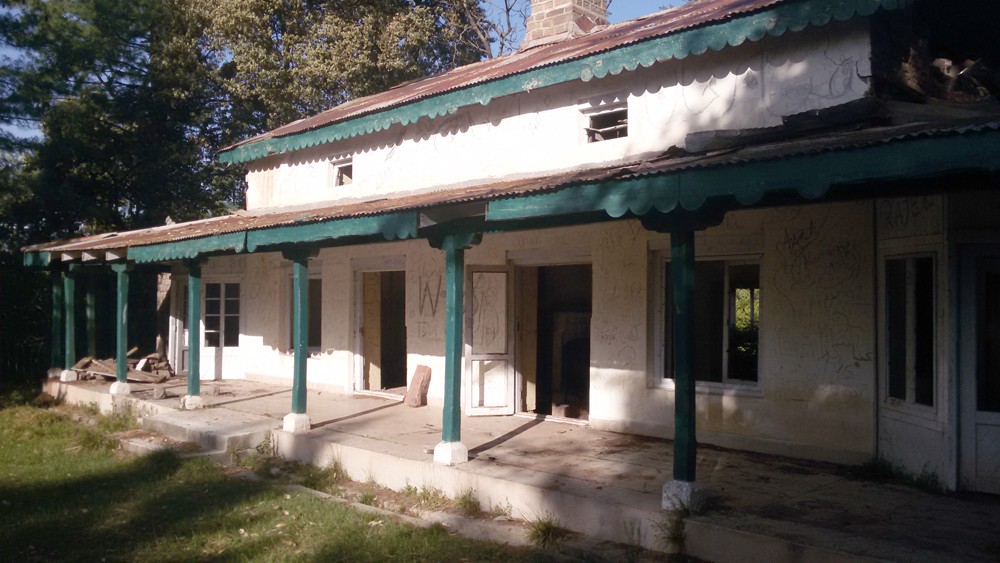
A colonial-era resthouse, a forest tower and a boali in Charehan must be saved from further neglect

Having failed a number of times in finding Charehan forest resthouse near Lower Topa, I accepted an offer for guidance from my friend and forester-turned-civil servant Rizwan Mahboob; and one fine morning, I found myself, Rizwan and Faisal standing near the Jheeka Gali turn on new Murree Motorway. Soon, an experienced forest guard, Zubair, in his immaculately crisp uniform joined us. He was deputed to guide us to the Charehan forest resthouse through the dense blue pine forest.
We started walking on the bridle path to Patriata through Gulhera Gali, which is just below the Lower Topa forest offices. The sahibs used to travel in palkis or on horsebacks, along with their families, hence the name bridle paths.
You can see such bridle paths from Nathia Gali to Donga Gali to Ayubia to Khanspur and elsewhere too.
On our Charehan trek, as we crossed several natural streams, Rizwan gave us a short course in forestry, telling us about false dawn, forest compartment blocks, different varieties of pines and forest working plans. In about 15 minutes, we were standing in front of a pre-partition brick structure called baoli.
Though baoli, at times referred to as ancient step well, is quite common in Punjab plains, here it was designed to collect water from a running natural stream into a small pond to facilitate bathing as well as clothes washing.
Thereafter, our forest guard started climbing a parri, a narrow mountain path, to take us across various ridges, where slopes were gentle and at times not so gentle. Rizwan told us how these parris are kept clean by forest coolies to contain accidental fire. In case of fire, coolies are despatched to the affected area to clean the parris of any dry wood or pine leaves to create a natural barrier in the middle of forests.
We trekked uphill through the dense blue pines to reach a broken jeep road. We could have taken this road to Charehan forest resthouse, starting about two kilometres on right, before the Jheeka Gali turn on Islamabad-Murree Motorway, but then trekking through dense pine forest early in the morning has its own rewards.
While walking towards Charhan resthouse through deep jungle, wild pheasants crossed us but, luckily or not, leopards did not.
Finally, the 1913 built Charehan forest resthouse constructed at a cost of Rs3,190 was in front of us. It was a typical early 20th century forest resthouse with broad steps leading to it, typical slanting iron sheet roof, a couple of rooms with Victorian fireplaces and wooden floors, a common veranda and a main front lawn.
Pity that the century-old resthouse was substantially destroyed during the 2005 earthquake and never rebuilt. The government has apparently approved building a new resthouse on this spot, so soon this old colonial structure shall go down -- along with the stories it has been privy to for over a century.
Our next stop was the last standing colonial forest tower on a mountaintop about 15 minutes uphill from Charehan forest resthouse. The British were meticulous about protecting forests, so they had these forest towers constructed at various places in forests. A guard would watch out for fires as well as unscrupulous activities, like cutting of trees, from atop the tower. In case of any fire, he would send a runner to the headquarter, to report the exact location of fire and request for the despatch of coolies to fight fire.
Now this forest tower was no mean tower, it was a huge steel structure with stairs winding around it to climb to the top observation post. The tower definitely had a commanding view of the surrounding jungle, as it was almost a hundred feet high and perched on a mountaintop.
Despite temptations to climb to the top of the tower, we decided to be pragmatic, and stayed on the ground.
Zubair, our guide, skilfully negotiated the trek down to the road through a shortcut, where we slipped and stumbled, but finally reached the main road.
On our way back, we stopped at the forest offices Lower Topa to see the visitor’s book of the Charehan forest resthouse. The book is kept here now since the 2005 earthquake that damaged the resthouse.
The visitors’ books of colonial-era resthouses are relics. So here I was, with the century-old visitors’ book in front of me, while sipping the famous forester’s tea. The first recorded visitor was a couple Mr and Mrs Blascheck in 1915 and the last was a general from the historic Guides Cavalry just before the 2005 earthquake.
The resthouse was graced by Lord Elmworth of Blandings Castle in Surrey in 1929, who wrote that "Some of the pleasure of staying at this beautiful lodge is mitigated by the lack of such necessities like water, bedding etc".
Mr and Mrs K.C. Robinson and Pratap Singh of Imperial Forest Service seemed to be frequent visitors.
Someone wrote in 1918, "Visitors are requested to see before they go that their servants leave crockery, house and surroundings clean".
These forest resthouses in the Murree area are valuable assets. While we should ensure that our foresters have them available for their official duties, there is a huge potential of using them for tourism purposes as well. There is a whole string of forest resthouses perched on mountaintops all over Murree Hills, including Jheeka Gali, Charehan, Patriata, Ghora Gali, Lehtrar, Danoi, Nurr, Rajgarh, Karor and Sambli. The Sambli resthouse is now a strategic asset not open to civilians anymore.
Long time ago, Dr Mahboob ul Haq and his wife used to spend time in Sambli, perhaps the place they contemplated poverty eradication and human development.
The historic Charehan resthouse, forest tower and baoli need immediate attention, before it crumbles due to neglect.